The South Beach Diet (16 page)

SUGAR SUBSTITUTES
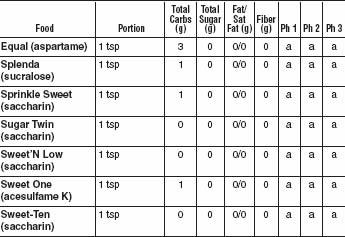
SYRUPS
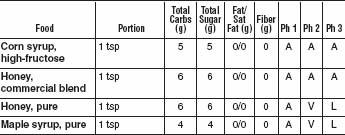

VEGETABLES
Eat and enjoy plenty of vegetables. They are low in calories but high in vitamins, essential nutrients, and fiber. Look for brightly colored vegetables, which contain antioxidants, such as Vitamins A, C, and E. Opt for as much variety as possible, and yes, even carrots are fine. In addition to their nutrient contribution, vegetables, especially when eaten raw, are a great source of fiber and bulk. When cooked in water, vegetables quickly lose their nutrients, so when you cook your vegetables do so in as little water as possible, and for as short a time as possible.
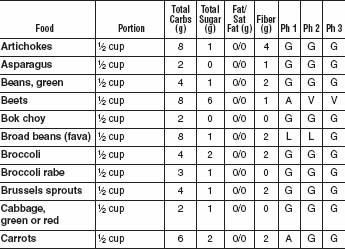
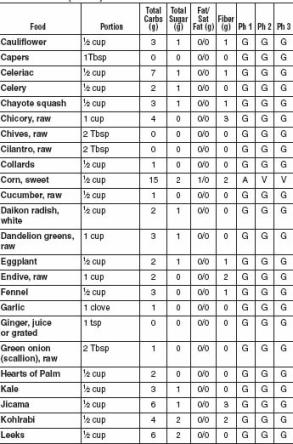
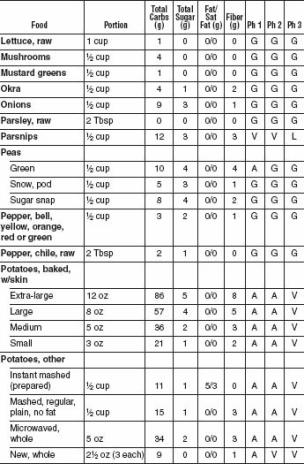
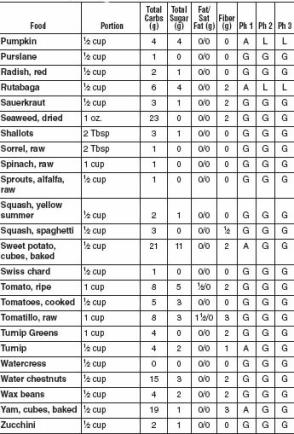
There’s nothing worse than arriving home from work hungry and discovering that the cupboard is bare. Keep the following staple items in your freezer and pantry, and you’ll always have the makings of a healthy South Beach meal.
Dairy
Reduced-fat or fat-free cheese:
Try American, Cheddar, mozzarella, ricotta, and Swiss—you’ll find countless varieties. Experiment with different brands until you find one you like.
Fat-free plain yogurt:
Use it as a staple for making “cream” sauces or dips. (Put it in a sieve lined with a coffee filter and refrigerate it for 3 or more hours, then combine it with your favorite seasonings.)
Flavor Boosters
Balsamic vinegar:
It wakes up salads, is a fat-free way to sauté, and is great combined with olive oil in marinades.
Garlic:
No well-stocked kitchen is complete without garlic, a staple of Mediterranean cuisine.
Olive and canola oils.
For the best-tasting salad dressings, light sautéing, dips for bread, or dressing for steamed vegetables, buy extra virgin olive oil. Canola oil is good for stir-fries.
Onions:
Keep a couple of these on hand: red, yellow, and white onions; shallots; and scallions.
Salsa:
Use fresh or jarred salsa in place of ketchup and as an accompaniment for grilled meat, poultry, or seafood.
Sesame oil and reduced-sodium soy sauce:
These flavor boosters add instant Asian flavor to steamed vegetables, stir-fries, and marinades. Refrigerating these items will help them preserve their flavor if you don’t use them up quickly.
Meat, Poultry, and Fish
Boneless top sirloin:
For quick and easy beef-and-vegetable kebabs, skewer the meat with mushrooms and chunks of red pepper and onion.
Boneless turkey and chicken breast:
Grill it, bake it, or use it in stir-fries.
Veggies and Beans
Beans:
Try all kinds—black, butter, lentils, limas, kidney, chickpeas, green, Italian, and split peas.
Frozen vegetables:
Keep broccoli and cauliflower florets, asparagus, and chopped spinach on hand for stir-fries, sautéed or microwaved side dishes, additions to casseroles and soups, and Mediterranean dishes like ratatouille.
Prewashed, prepackaged broccoli florets:
Serve them as no-fuss crudités with reduced-fat or fat-free cheese, sauté them with black beans as a side dish, or add them to a readymade soup.
It’s one thing to follow a straight-from-the-book diet plan, quite another to assemble your own healthy meals. But it’s not as hard as it may seem. Simply pair a serving of lean protein with a serving of fiber-rich, fresh veggies (other than high-glycemic varieties like corn and potatoes). Add a dash of healthy oils. Presto—you’ve got a delicious meal that slows your digestion and keeps you feeling satisfied for hours.
These before-and-after breakfast, lunch, and dinner “makeovers” will help inspire you to think of your own tempting combos. Pair what you know about the nutritional principles of the diet with your own favorite foods and a little creativity and the sky’s the limit.
SWITCH FROM THIS… | | …TO THIS |
BREAKFAST
Omelet with cheese, hash browns, bacon or pork sausage, and orange juice (from concentrate) | Veggie omelet, Canadian bacon, an orange, and fat-free milk |
Plain bagel and a mocha latte | One slice whole wheat toast with no sugar-added peanut butter and coffee with 1% milk and sugar substitute |
Pancakes topped with syrup | Whole grain pancakes topped with fresh fruit |
LUNCH
Salad with fat-free dressing and pasta with red sauce | Tossed salad with olive oil and vinegar dressing (vinaigrette) and whole grain pasta with shrimp and veggies |
Cheeseburger and fries | Grilled chicken breast sandwich on a whole grain roll |
Veggie wrap | Tuna salad and veggies wrapped in lettuce |
DINNER
Fried chicken, white rice, and a biscuit | Baked chicken breast, steamed asparagus, and a tossed salad with vinaigrette |
Meat loaf, mashed potatoes, and bread spread with margarine | Broiled sirloin steak, sweet potato, and oven-roasted veggies |
Pork barbecue on a bun, corn, and a tossed salad with fat-free dressing | Cup of tomato soup, open-faced roast beef sandwich, and a tossed salad with vinaigrette |
You don’t have to stop frequenting your favorite restaurants just because you’re on the South Beach Diet. This way of eating is flexible so that you can find several healthy choices that allow you to enjoy the dining-out experience and still lose or maintain weight. This cheat sheet will help you select the healthiest choices virtually anywhere—even at ethnic restaurants.
Regardless of which Phase of the Diet you’re on, be guided by the ground rules for South Beach eating.
Chain Restaurants
Upscale chains offer so much variety that there’s plenty to choose from other than deep-fried appetizers, huge entrée portions, and frozen margaritas. At all chain restaurants, avoid appetizers smothered in cheese and sour cream (such as nachos or potato skins), sandwiches called melts (tuna melt, for instance, which are loaded with cheese and grilled with butter), croissant sandwiches, coleslaw, macaroni and potato salads, and fried tortilla shell or bread “bowls.”
Try these instead:
At Boston Market:
A quarter of a chicken, white meat, no skin or wing; a chicken, turkey, or ham sandwich without cheese or dressing; any fresh vegetable, such as green beans or broccoli.
At Chili’s:
The Guiltless Grill items, which are usually served with black beans or steamed veggies; shrimp, chicken, or beef fajitas, topped with salsa and minus the flour tortillas and full-fat cheese and sour cream.
At Ruby Tuesday:
The salad bar, which contains all the makings for a healthy salad (greens, chickpeas, fresh vegetables, diced turkey or ham, olive oil and balsamic dressing); a turkey burger without the bun; grilled chicken or grilled-chicken salads without the cheese or deep-fried tortilla bowl.
Chinese Food
To give Americanized Chinese food a South Beach makeover, minimize the huge amounts of saturated fat used to prepare it. Ask that your dish be prepared without MSG, the flavoring agent often used in Chinese cuisine. While it’s made from beets, a healthy vegetable, MSG has a very high glycemic index (GI). Try egg drop soup or any combination of steamed fresh vegetables prepared with small amounts of meat, poultry, or seafood. Stay away from: steamed rice (it has a high GI); the deep-fried, crispy noodles; egg rolls; fried dumplings; spareribs; lo mein; moo goo gai pan; Peking duck; and entrées described on the menu as “crispy” or “sweet and sour.” Also, many sauces may be thickened with cornstarch. Ask the waiter for sauces prepared without added cornstarch.
Indian Food
Indian food is based on good carbs, particularly legumes like chickpeas and lentils, and veggies such as spinach and eggplant. The downside is its abundance of starchy carbs (like potatoes) and bad fats. Many appetizers are deep-fried, and vegetables and meats are typically fried or sautéed in the Indian butter called
ghee
. Still, most Indian restaurants provide several tasty choices for the South Beach dieter. Try Mulligatawny soup, dals (legume dishes—choose those without cream), chana (chickpea curry), kachumbars (vegetable salads), raitas (salads with a tart yogurt dressing), or dishes described on the menu as masala (a combination of spices with sautéed tomatoes and onions) or tandoori (seasoned meat, poultry, or fish roasted in a clay oven).
Stay away from Samosas (deep-fried pastry filled with vegetables or meat); puri (a puffy, deep-fried bread); and entrées described as biryani, malai, or korma, which are heavy on the oil and cream.
Italian Food
Not order pasta? At an Italian restaurant? Actually, it’s easier than you think—there are usually several choices right for the South Beach dieter. Try salads dressed with oil and balsamic vinegar; clams steamed in white wine; clear soups; grilled meat, poultry, or fish; scallops sautéed with mushrooms and marsala wine sauce; or escarole or broccoli rabe (two types of greens) sautéed in garlic and olive oil.
If you order pizza, request a thin-crust pie rather than Sicilian or deep-dish, and pile it with veggies rather than sausage or pepperoni. If you must have pasta, ask for whole wheat pasta and order a side serving sautéed in olive oil and garlic or topped with plain tomato sauce and good proteins (clams or shrimp) or vegetables. Stay away from bread or garlic bread; antipastos with cheeses and salami, which are high in saturated fat; and anything described on the menu as “carbonara” (prepared with full-fat cream and cheese) or parmigiana (breaded, fried, and smothered in full-fat mozzarella).
Mexican Food
Most Mexican food at chain restaurants and Mexican fast-food places is prepared American-style, which means an abundance of bad fats. Yet it is possible to go Mexican and eat healthfully. Try grilled chicken or fish,
pescado Veracruzana
(fish in a tangy sauce of olive oil, grilled onions, green olives, and capers),
mole pollo
(boned chicken breast served in a hot and spicy sauce),
mojo pollo
(chicken in a tangy citrus sauce), or
camarones de hacha
(shrimp sautéed in a red and green tomato sauce). Stay away from deep-fried tortilla chips; anything topped with cheese, sour cream, or guacamole; refried beans (commonly fried in lard); chimichangas (deep-fried flour tortillas filled with meat and cheese); the Mexican sausage called chorizo; and deep-fried taco-shell bowls.
Steak Houses
You should be able to have a good South Beach meal in a restaurant specializing in steaks and vegetables. Order a lean cut of meat and enjoy it with a cup of broth-based soup and a side dish of steamed or grilled vegetables.
Try lean cuts of beef such as top sirloin or tenderloin or a well-trimmed lamb or pork loin chop (ask that the extra fat be trimmed away before cooking). At the salad bar, opt for peel-and-eat shrimp, shrimp cocktail, and salad greens with broccoli and other nonstarchy vegetables dressed with olive oil and balsamic vinegar.
Stay away from deep-fried appetizers, creamy soups such as New England clam chowder, baby back ribs, coleslaw, macaroni and potato salads, baked potatoes, steak fries, and onion rings.
